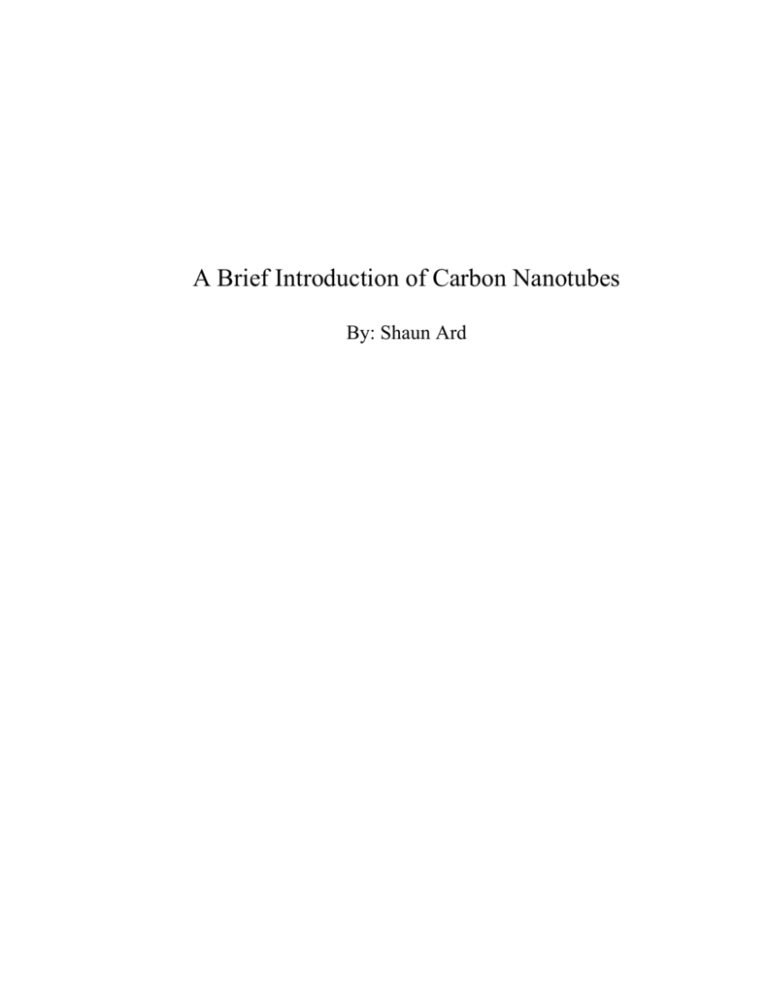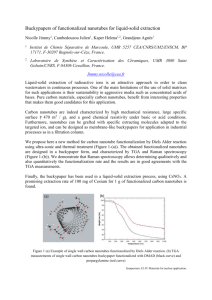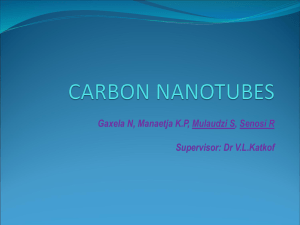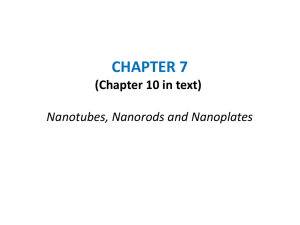Paper
advertisement

A Brief Introduction of Carbon Nanotubes By: Shaun Ard I. Intro Since their initial observation by Kroto et al1 during investigations of carbon chains, the family of carbon molecules known as Fullerenes provide an area of exploration that is adding to our knowledge of fundamental physics as well as the promise of future applications. Fullerenes are cage like structures of "honeycomb" type lattices, consisting of varying numbers of hexagonal and pentagonal cells. Of particular interest is the subfamily of "nanotubes". Nanotubes provide insight into one-dimensional quantum systems, as well as offer massive potential for application into a multitude of fields2,3. II. Discovery and Synthesis The discovery of carbon nanotubes is generally attributed to S. Iijima4 while investigating the arc discharge method for producing fullerenes. Iijima noticed tiny needles on one of the electrodes. This observation turned out to be multi-walled carbon nanotubes (MWNTs). These MWNTs, are composed of multiple layered graphitic shells as shown in Figure 1. They ranged from 2-50 layers thick, and had diameters on the order of 10s of nanometers. It should be noted that these nanotubes may have been observed earlier, such as in work by Oberlin et al.5, but it was only with the use of high resolution electron micrographs taken by Iijima which allowed for the systematic study and true identification as layered coaxial tubes. Two years after this initial report, Iijima and Ichihashi6 as well as Bethune et al.7 were able to create single walled tubes (SWNTs). Both groups used an arc discharge of graphitic rods with an included catalyst, iron for Iijima's group and cobalt for Bethune's. MWNTs still formed on the electrodes during this process but the SWNTs form in the soot, often in bundles or ropes. This was the first step into large scale production of SWNTs for comparison to theoretical models. Figure 1. High resolution transmission electron micrscopy images of MWNTs produced by Iijima using an arc discharge preparation method. (Iijima) Today, there are several methods for high yield production of SWNTs. The arc discharge method used by the pioneering groups has been enhanced to produce large quantities of bundled carbon nanotubes with a fairly narrow distribution of diameters. In 1996 a technique was presented using laser ablation of graphite, again with catalysts present. This process provided large yield of nearly uniform diameter, but as with the arc discharge method they tended to bundle into ropes.8 However Li et al. developed a method of chemical vapor deposition (CVD) along with catalysts embedded into a substrate to produce large amounts of aligned carbon nanotubes9 as seen in Figure 2. Now one could begin to compare experimental work with theoretical models without the concern of differing diameters or orientations of tubes obscuring results. Figure 2. Scanning electron microscopy image of aligned carbon nanotubes produced by Li et al using the CVD process. (Li) III. Properties: Foundation Before beginning discussion on the interesting electronic and physical properties of nanotubes, it is important to form a proper basis with which to describe the many variations they take. One begins with a graphene sheet and its familiar hexagonal unit cell. Two unit vectors â1 and â2 are used to form the chiral vector, Ch = n â1 + m â2, which describes how the graphene sheet is “rolled up” to form the nanotubeas illustrated in Figure 3. This chiral vector along with the the chiral angle, which is the angle the chiral vector makes with respect to â1, are used to classify nanotubes into 3 major groups: armchair nanotubes have n = m and the chiral angle is 30, zigzag is where either n or m is zero and the chiral angle is 0, and chiral nanotubes are the remaining nanotubes with chiral angles between 0 and 30. The ends of the nanotubes are “caps” composed of hemispheres of the appropriate fullerene. The nanotubes end is composed of 6 pentagonal cells (closed fullerenes have exactly 12 pentagonal cells) and suitable number of hexagons to fit the cylindrical structure. Below, in Table 1, is a selection of important parameters of nanotubes as prepared by Dresselhaus et al.10. Many electronic and physical properties are directly related to these parameters. Figure 3. Schematic representation showing the formation of the nanotubes from a graphene sheet (a). Tubes are classified as armchair (Ba), zigzag (Bb), or chiral (Bc) (Popov). Table 1. Table of important physical charcteristics of carbon nanotubes. (Dresselhaus et al.) IV. Properties: Electronic Upon beginning to model carbon nanotubes, one immediately assumes the tubes are orders of magnitude longer than they are wide. This allows for the neglect of the fullerene end caps. The nanotube can then be modeled well using the well known 2-D graphene sheet. A simple model of “zone folding” gives the one-dimensional dipsersion relation as a cross section of the two dimensional graphene case. Using this model it was found that the nanotubes could exhibit both metalic or semiconducting properties. Specifically it was found that if (n-m) was evenly divisible by 3 then the nanotube would be metalic. All others would be semiconducting. Work first presented by Odom et al.11 showed that through scanning tunneling microscopy (STM) one can probe both the atomic structure and electronic density of states simultaneously. Their results seemingly agree with the (n-m) prediction of the simple model, and furthermore shows an inversely proportional relationship of the band gap and diameter for semiconducting tubes. Most importantly they showed the promise of the technique for furthering the models for such systems. V. Properties: Mechanical In addition to these interesting electronic properties, SWNTs and MWNTs exhibit remarkable mechanical characteristics. Work done by Treacy's group found that both single and multi-walled tubes exhibited very high Young's moduli, by looking at the mean squared vibrational amplitude due to thermal vibrations12,13. More recently Atomic Force Microscopy (AFM) has been used to directly measure mechanical properties such as Young's modulus and shear modulus between walls of a MWNT. Lukic et al. used this technique to look into the seemingly lower value of Young's modulus for tubes produced through CVD as opposed to arc discharge or laser ablation14. This is an important issue for industrial application, as the CVD technique is the best candidate for large scale production (on the order of kilograms to tons). They found that small diameter tubes exhibited high Young's modulus, comparable to other production methods, decaying exponentially with increasing size. They attributed this to a higher defect density for larger tubes lowering their strength. Improved understanding of properties such as this will improve our understanding of the growth mechanisms for different preparation methods. VI. Application Due to the novel electronic and mechanical properties briefly discussed above, carbon nanotubes are being applied to a wide range of applications. The high Young's modulus makes them an ideal candidate for use in composite materials. Whereas now many composites include micron size or larger carbon fibers, nanotubes would offer greater strength with less weight. The one-dimensional electronic nature of nanotubes makes them useful for nanoscale electronics. Semiconducting tubes have been shown to be capable of acting as field effect transistors, even at room temperature15. Additional possibilities range from AFM (atomic force microscopy) tips, to robust nanowires, or even as intercolation hosts in lithium ion batteries. Although these are but a few of the current and potential applications the possibilities are seemingly unbounded. VII. Conclusion In conclusion, carbon nanotubes have a great deal to offer the fundamental scientist and engineer alike. They form a one dimensional system ideal for adding insight to physical models at the nanoscale level. Additionally, the unique mechanical and electronic properties exhibited offer incredible opportunities for contributions spanning many fields of science and engineering. Although still in its infancy, study of this material has truly opened a field unto its own. 1 H.W. Kroto, J.R. Heath, S.C. O'Brien, R.F. Curl, R.E. Smalley, C60:buckminsterfullerene, Nature 318 (1985) 162 2 V. Popov, Carbon nanotubes: properties and applications, Materials Science and Engineering R 43 (2004) 61-102 3 P. M. Ajayan, J.C. Charlier, and A. G. Rinzler, Carbon nanotubes: From macromolecules to nanotechnology, PNAS 96 (1999) 14199 4 S. Iijima, Helical microtubules of graphitic carbon, Nature (London) 354 (1991) 56 5 A. Oberlin, M. Endo, T. Koyama, Filamentous Growth of Carbon Through Benzene Decomposition, Journal of Crystal Growth 32 (1976) 335-349 6 S. Iijima, T. Ichihashi, Single-shell carbon nanotubes of 1-nm diameter, Nature (London) 363 (1993) 603 7 D.S. Bethune, C.H. Kiang, M.S. de Vries, G. Gorman , R. Savoy, J. Vasquez, R. Beyers, Cobalt-catalysed growth of carbon nanotubes with single-atomic-layer walls, Nature (London) 363 (1993) 605 8 Andreas Thess; Roland Lee; Pavel Nikolaev; Hongjie Dai; Pierre Petit; Jerome Robert; Chunhui Xu; Young Hee Lee; Seong Gon Kim; Andrew G. Rinzler; Daniel T. Colbert; Gustavo E. Scuseria; David Tománek; John E. Fischer; Richard E. Smalley, Crystalline Ropes of Metalic Carbon Nanotubes, Science 273 (1996) 483 9 W.Z. Li, S.S. Xie, L.X. Qian, B.H. Chang, B.S. Zhou, R. A. Zhau, G. Wang, Large Scale Synthesis of Aligned Carbon Nanotubes, Science 274 (1996) 1701 10 M. S. Dresselhaus, G. Dresselhaus, R. Saito, Physics of Carbon Nanotubes, Carbon 33 (1995) 883 11 T.W. Odom, J. Huang, P. Kim, C. Lieber, Atomic Structure and Electronic Properties of Single-Walled Nanotubes, Nature (London) 391 (1998) 62 12 M. M. Treacy, T. W. Ebbesen, L. M. Gibson, Exceptionally High Young's Modulus Observed for Individual Carbon Nanotubes, Nature (London) 381 (1996) 678 13 A. Krishnan, E. Dujardin, T. W. Ebbsen, P N. Yianilos, Young's Modulus of Single Walled Nanotubes, Phys. Rev. B 58 (1998) 14013 14 B. Lukic´, J. W. Seo, R. R. Bacsa, S. Delpeux, F. Be´guin, G. Bister, A. Fonseca, J. B. Nagy, A. Kis, S. Jeney, A. J. Kulik, L. Forro´, Catalytically Grown Carbon Nanotubes of Small Diameter Have a High Young’s Modulus, Nano Letters 5 (2005) 2074 15 S. J. Tans, A.R.M. Verschueren, C. Dekker, Room-temperature transistor based on a single carbon nanotubes, Nature (London) 393 (1998) 6680






